Romanticism in Scotland
| History of Scotland |
|---|
 |
|
|
Romanticism in Scotland was an artistic, literary and intellectual movement that developed between the late eighteenth and the early nineteenth centuries. It was part of the wider European
In the arts, Romanticism manifested itself in literature and drama in the adoption of the mythical bard
Intellectually, Scott and figures like
Romanticism began to subside as a movement in the 1830s, but it continued to significantly affect areas such as music until the early twentieth century. It also had a lasting impact on the nature of Scottish identity and outside perceptions of Scotland.
Definitions
Romanticism has been seen as "the revival of the life and thought of the Middle Ages", reaching beyond Rationalist and Classicist models to elevate medievalism and elements of art and narrative perceived to be authentically medieval, in an attempt to escape the confines of population growth, urban sprawl and industrialism, embracing the exotic, unfamiliar and distant.[8] It is also associated with political revolutions, beginning with those in Americana and France and movements for independence, particularly in Poland, Spain and Greece. It is often thought to incorporate an emotional assertion of the self and of individual experience along with a sense of the infinite, transcendental and sublime. In art there was a stress on imagination, landscape and a spiritual correspondence with nature. It has been described by Margaret Drabble as "an unending revolt against classical form, conservative morality, authoritarian government, personal insincerity, and human moderation".[9]
Literature and drama

Although after
Robert Burns (1759–96) and Walter Scott (1771–1832) were highly influenced by the Ossian cycle. Burns, an Ayrshire poet and lyricist, is widely regarded as the national poet of Scotland and a major influence on the Romantic movement. His poem (and song) "Auld Lang Syne" is often sung at Hogmanay (the last day of the year), and "Scots Wha Hae" served for a long time as an unofficial national anthem of the country.[14] Scott began as a poet and also collected and published Scottish ballads. His first prose work, Waverley in 1814, is often called the first historical novel.[15] It launched a highly successful career, with other historical novels such as Rob Roy (1817), The Heart of Midlothian (1818) and Ivanhoe (1820). Scott probably did more than any other figure to define and popularise Scottish cultural identity in the nineteenth century.[16] Other major literary figures connected with Romanticism include the poets and novelists James Hogg (1770–1835), Allan Cunningham (1784–1842) and John Galt (1779–1839).[17]
Scotland was also the location of two of the most important literary magazines of the era,
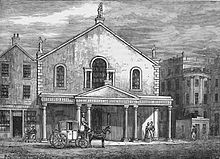
Scottish "national drama" emerged in the early 1800s, as plays with specifically Scottish themes began to dominate the Scottish stage. Theatres had been discouraged by the
The Scottish national drama that emerged in the early nineteenth century was largely historical in nature and based around a core of adaptations of Scott's Waverley novels.
Art

The Ossian cycle itself became a common subject for Scottish artists, and works based on its themes were created by figures such as Alexander Runciman (1736–85) and David Allan (1744–96).[25][26] This period saw a shift in attitudes to the Highlands and mountain landscapes in general, from viewing them as hostile, empty regions occupied by backward and marginal people, to interpreting them as aesthetically pleasing exemplars of nature, occupied by rugged primitives, who were now depicted in a dramatic fashion.[27] Produced before his departure to Italy, Jacob More's (1740–93) series of four paintings "Falls of Clyde" (1771–73) have been described by art historian Duncan Macmillan as treating the waterfalls as "a kind of natural national monument" and has been seen as an early work in developing a romantic sensibility to the Scottish landscape.[27] Runciman was probably the first artist to paint Scottish landscapes in watercolours in the more romantic style that was emerging towards the end of the eighteenth century.[28]
The effect of Romanticism can also be seen in the works of late eighteenth- and early nineteenth-century artists such as Henry Raeburn (1756–1823), Alexander Nasmyth (1758–1840) and John Knox (1778–1845). Raeburn was the most significant artist of the period to pursue his entire career in Scotland. He was born in Edinburgh and returned there after a trip to Italy in 1786. He is most famous for his intimate portraits of leading figures in Scottish life, going beyond the aristocracy to lawyers, doctors, professors, writers and ministers,[29] adding elements of Romanticism to the tradition of Reynolds.[30] He became a knight in 1822 and the King's limner and painter for Scotland in 1823.[29] Nasmyth visited Italy and worked in London, but returned to his native Edinburgh for most of his career. He produced work in a range of forms, including his portrait of Romantic poet Robert Burns, which depicts him against a dramatic Scottish background, but he is chiefly remembered for his landscapes and has been seen as "the founder of the Scottish landscape tradition".[31] The work of Knox continued the theme of landscape, directly linking it with the Romantic works of Scott,[32] and he was also among the first artists to depict the urban landscape of Glasgow.[33]
Architecture
The Gothic revival in architecture has been seen as an expression of Romanticism, and according to
Important for the re-adoption of the Scots Baronial in the early nineteenth century was
In ecclesiastical architecture, a style similar to that developed in England was adopted. Important figures in this movement included
Music

One characteristic of Romanticism was the conscious creation of bodies of nationalist
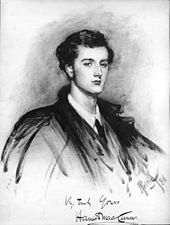
Perhaps the most influential composer of the first half of the nineteenth century was the German
By the late nineteenth century, there was in effect a national school of orchestral and operatic music in Scotland. Major composers included Alexander Mackenzie (1847–1935), William Wallace (1860–1940), Learmont Drysdale (1866–1909), Hamish MacCunn (1868–1916) and John McEwen (1868–1948).[41] Mackenzie, who studied in Germany and Italy and mixed Scottish themes with German Romanticism,[48] is best known for his three Scottish Rhapsodies (1879–80, 1911), Pibroch for violin and orchestra (1889) and the Scottish Concerto for piano (1897), all involving Scottish themes and folk melodies.[41] Wallace's work included an overture, In Praise of Scottish Poesie (1894); his pioneering symphonic poem about his namesake, medieval nationalist William Wallace AD 1305–1905 (1905); and a cantata, The Massacre of the Macpherson (1910).[49] Drysdale's work often dealt with Scottish themes, including the overture Tam O’ Shanter (1890), the cantata The Kelpie (1891), the tone poem A Border Romance (1904), and the cantata Tamlane (1905).[50] MacCunn's overture The Land of the Mountain and the Flood (1887), his Six Scotch Dances (1896), his operas Jeanie Deans (1894) and Dairmid (1897) and choral works on Scottish subjects[41] have been described by I. G. C. Hutchison as the musical equivalent of Abbotsford and Balmoral.[51] McEwen's more overtly national works include Grey Galloway (1908), the Solway Symphony (1911) and Prince Charlie, A Scottish Rhapsody (1924).[41]
Historiography
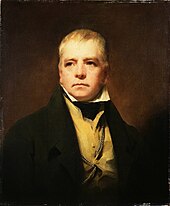
In contrast to Enlightenment histories, which have been seen as attempting to draw general lessons about humanity from history, the German philosopher
An important element in the emergence of a Scottish national history was an interest in antiquarianism, with figures like John Pinkerton (1758–1826) collecting sources such as ballads, coins, medals, songs and artefacts.[54] Enlightenment historians had tended to react with embarrassment to Scottish history, particularly the feudalism of the Middle Ages and the religious intolerance of the Reformation. In contrast many historians of the early nineteenth century rehabilitated these areas as suitable for serious study.[55] Lawyer and antiquarian Cosmo Innes, who produced works on Scotland in the Middle Ages (1860), and Sketches of Early Scottish History (1861), has been likened to the pioneering history of Georg Heinrich Pertz, one of the first writers to collate the major historical accounts of German history.[56] Patrick Fraser Tytler's nine-volume history of Scotland (1828–43), particularity his sympathetic view of Mary, Queen of Scots, have led to comparisons with Leopold von Ranke, considered the father of modern scientific historical writing.[56] Tytler was co-founder with Scott of the Bannatyne Society in 1823, which helped further the course of historical research in Scotland.[57] Thomas M'Crie's (1797–1875) biographies of John Knox and Andrew Melville, figures generally savaged in the Enlightenment, helped rehabilitate their reputations.[58] W. F. Skene's (1809–92) three part study of Celtic Scotland (1886–91) was the first serious investigation of the region and helped spawn the Scottish Celtic Revival.[58] Issues of race became important, with Pinkerton, James Sibbald (1745–1803) and John Jamieson (1758–1839) subscribing to a theory of Picto-Gothicism, which postulated a Germanic origin for the Picts and the Scots language.[54]
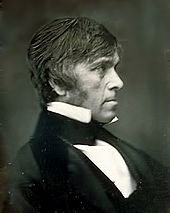
Among the most significant intellectual figures associated with Romanticism was
Romantic writers often reacted against the
Science

Romanticism has also been seen as affecting scientific enquiry. Romantic attitudes to science varied, from distrust of the scientific enterprise to endorsing a non-mechanical science that rejected the mathematicised and the abstract theorising associated with Newton. Major trends in continental science associated with Romanticism include Naturphilosophie, developed by Friedrich Schelling (1775–1854), which focused on the necessity of reuniting man with nature,[69] and Humboldtian science, based on the work of Alexander von Humboldt (1769–1859). As defined by Susan Cannon, this form of inquiry placed a stress on observation, accurate scientific instruments and new conceptual tools; disregarded the boundaries between different disciplines; and emphasised working in nature rather than the artificial laboratory.[70] Privileging observation above calculation, Romantic scientists were often attracted to the areas where investigation, rather than calculation and theory, was most important, particularly the life sciences, geology, optics and astronomy.[71]
James Allard identifies the origins of Scottish "Romantic medicine" in the work of Enlightenment figures, particularly the brothers

The University of Edinburgh was also a major supplier of surgeons for the royal navy, and Robert Jameson (1774–1854), Professor of Natural History at Edinburgh, ensured that a large number of these were surgeon-naturalists, who were vital in the Humboldtian and imperial enterprise of investigating nature throughout the world.[70][77] These included Robert Brown (1773–1858), one of the major figures in the early exploration of Australia. His later use of the microscope paralleled that noted among German students of Naturphilosophie, and he is credited with the discovery of the cell nucleus and the first observation of Brownian motion.[78] Charles Lyell's work Principles of Geology (1830) is often seen as the foundation of modern geology. It was indebted to Humboldtian science in its insistence on measurements of nature,[79] and, according to Noah Heringman, retains a much of the "rhetoric of the sublime", which is characteristic of Romantic attitudes to landscape.[80]
Romantic thinking was also evident in the writings of
Politics
In the aftermath of the Jacobite risings, a movement to restore Stuart King James II of England to the throne, the British government enacted a series of laws that attempted to speed the process of the destruction of the clan system. Measures included a ban on the bearing of arms, the wearing of tartan and limitations on the activities of the Episcopalian Church. Most of the legislation was repealed by the end of the eighteenth century as the Jacobite threat subsided.
Soon after, there was a process of the rehabilitation of highland culture. Tartan had already been adopted for highland regiments in the British army, which poor highlanders joined in large numbers until the end of the
The romanticisation of the Highlands and the adoption of Jacobitism into mainstream culture have been seen as defusing the potential threat to the Union with England, the
Philosophy
The dominant school of philosophy in Scotland in the late eighteenth century and the first half of the nineteenth century is known as Common Sense Realism. It argued that there are certain concepts, such as our existence, the existence of solid objects and some basic moral "first principles", that are intrinsic to our make-up and from which all subsequent arguments and systems of morality must be derived. It can be seen as an attempt to reconcile the new scientific developments of the Enlightenment with religious belief.
Common Sense Realism not only dominated Scottish thought but also had a major impact in France,
Decline
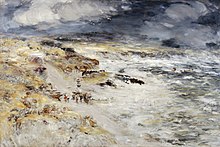
In literature, Romanticism is often thought to have ended in the 1830s,
In art, the tradition of Scottish landscape painting continued into the later nineteenth century, but Romanticism gave way to influences including French Impressionism, Post-Impressionism and eventually Modernism.[115] The Scots baronial style continued to be popular until the end of the nineteenth century, when other styles began to dominate.[116] Although Romanticism persisted in music much longer than in almost every area, it fell out of fashion in the twentieth century and anti-Romantic currents in Britain virtually buried Victorian and Edwardian music not written by Edward Elgar or Arthur Sullivan.[49] The idea of the historical imagination was replaced with the source-based empiricism championed by Ranke.[117] Marinel Ash has noted that after the death of Scott, Scottish national history lost its momentum, and the Scottish literati stopped writing Scottish histories. Colin Kidd has observed a change of attitudes to historical writing and suggests that this was one reason for a lack of the development of political nationalism.[53] In science, the rapid expansion of knowledge increased a tendency towards specialisation and professionalism and a decline of the polymath "man of letters" and amateurs that had dominated Romantic science.[118] Common Sense Realism began to decline in Britain in the face of the English empiricism outlined by John Stuart Mill in his An Examination of Sir William Hamilton's Philosophy (1865).[119]
Influence
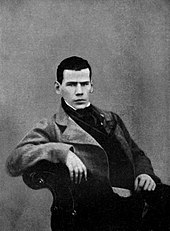
Scotland can make a claim to have begun the Romantic movement with writers such as Macpherson and Burns.[120] In Scott it produced a figure of international fame and influence, whose virtual invention of the historical novel would be picked up by writers across the world, including Alexandre Dumas and Honoré de Balzac in France, Leo Tolstoy in Russia and Alessandro Manzoni in Italy.[121] The tradition of Scottish landscape painting significantly influenced art in Britain and elsewhere through figures like J. M. W. Turner, who took part in the emerging Scottish "grand tour".[122] The Scottish baronial style influenced buildings in England and was taken by Scots to North America,[123] Australia[124] and New Zealand.[125] In music, the early efforts of men like Burns, Scott and Thompson helped insert Scottish music into European, particularly German, classical music, and the later contributions of composers like MacCuun were part of a Scottish contribution to the British revival of interest in classical music in the late nineteenth century.[126]
The idea of history as a force and the romantic concept of revolution were highly influential on transcendentalists like Emerson, and through them on American literature in general.[61] Romantic science maintained the prominence and reputation that Scotland had begun to obtain in the Enlightenment and helped in the development of many emerging fields of investigation, including geology and biology. According to Robert D. Purington, "to some the nineteenth century seems to be the century of Scottish science".[127] Politically the initial function of Romanticism as pursued by Scott and others helped to diffuse some of the tension created by Scotland's place in the Union, but it also helped to ensure the survival of a common and distinct Scottish national identity that would play a major part in Scottish life and emerge as a significant factor in Scottish politics from the second half of the twentieth century.[128] Externally, modern images of Scotland worldwide, its landscape, culture, sciences and arts, are still largely defined by those created and popularised by Romanticism.[129]
Notes
- ISBN 9780199232796.
- ^ "Re-Mapping Romanticism: The Scottish Question | Townsend Center for the Humanities". townsendcenter.berkeley.edu. Retrieved 30 July 2021.
- ^ a b A. Chandler, A Dream of Order: the Medieval Ideal in Nineteenth-Century English Literature (London: Taylor & Francis, 1971), p. 4.
- ^ David Levin, History as Romantic Art: Bancroft, Prescott, and Parkman (1967).
- ISBN 0826486444.
- ^ Ashton Nichols, "Roaring Alligators and Burning Tygers: Poetry and Science from William Bartram to Charles Darwin," Proceedings of the American Philosophical Society 2005 149(3): 304–315
- ^ Pittock, Murray (2008). Scottish and Irish Romanticism. Oxford: Oxford University Press.
- ^ R. R. Agrawal, The Medieval Revival and its Influence on the Romantic Movement (Abhinav, 1990), p. 1.
- ^ a b M. Drabble, The Oxford Companion to English Literature (Oxford: Oxford University Press, fifth edn., 1985), pp. 842–3.
- ISBN 0-06-055888-1, p. 311.
- ISBN 0-06-055888-1, p. 163.
- ISBN 0826461352, p. 140.
- ^ D. Thomson, The Gaelic Sources of Macpherson's "Ossian" (Aberdeen: Oliver & Boyd, 1952).
- ^ L. McIlvanney, "Hugh Blair, Robert Burns, and the Invention of Scottish Literature", Eighteenth-Century Life, vol. 29 (2), Spring 2005, pp. 25–46.
- ISBN 0-7546-6142-3, p. 28.
- ISBN 0-7453-1608-5, p. 136.
- ISBN 0816074968, p. 374.
- ISBN 0631233555, p. 60.
- ISBN 0754664465, p. 210.
- ISBN 0754664465, p. 209.
- ^ ISBN 0748624813, pp. 229–30.
- ^ ISBN 0748624813, p. 231.
- ^ ISBN 0748624813, pp. 185–6.
- ISBN 0754665690, p. 43.
- ISBN 019953294X, p. 554.
- ISBN 061825210X, pp. 34–5.
- ^ ISBN 0521642027, pp. 151–3.
- ISBN 0300058330, p. 293.
- ^ ISBN 1902669738, pp. 142–3.
- ISBN 1906261083, p. 84.
- ISBN 019953294X, p. 433.
- ISBN 0754668061, p. 104.
- ISBN 1550021591, p. 401.
- ISBN 019959399X, p. 152.
- ISBN 0415029929, p. 100.
- ISBN 0275984141, p. 154.
- ISBN 978-0-7486-0849-2, pp. 276–85.
- ISBN 0300053207, p. 146.
- ISBN 0719040205, pp. 108–10.
- ISBN 0-7486-0849-4, p. 552.
- ^ ISBN 0748620273, pp. 195–6.
- ISBN 0838756182, p. 77.
- ISBN 0203991117, p. 1054.
- ISBN 0203991117, pp. 16–18.
- ISBN 0836958039, p. 99.
- ^ D. Conway, " 'Short, Dark and Jewish-Looking': Felix Mendelssohn in Britain", Jewish Year Book (2009), ed. S. Massil, p. xviii.
- ISBN 052183483X, p. 130.
- ^ "Alexander Mackenzie" Scottish Composers: the Land With Music, retrieved 11 May 2012.
- ^ a b J. Stevenson, "William Wallace", Allmusic, retrieved 11 May 2011.
- ^ "Learmont-Drysdale" Scottish Composers: the Land With Music, retrieved 11 May 2012.
- ISBN 0191622435, p. 197.
- ISBN 0415462231, p. 274.
- ^ ISBN 0714655910, pp. 3–4.
- ^ ISBN 0521520193, p. 251.
- ISBN 0199563691, pp. 2–3.
- ^ ISBN 0199533091, p. 206.
- ISBN 3034303289, p. 195.
- ^ ISBN 0748624813, p. 9.
- ^ M. Cumming, The Carlyle Encyclopedia (Fairleigh Dickinson University Press, 2004), pp. 200ff and 223.
- ISBN 0299123642, p. 132.
- ^ ISBN 1438118562, pp. 7–9.
- ISBN 041501235X, p. 195.
- ISBN 0549497250, p. 101.
- ISBN 0520220617, pp. xxii–xxiii.
- ISBN 0300070233, pp. 33–4.
- ISBN 0192100548, p. 148.
- ISBN 1107001579, p. 265.
- ISBN 0521522234, p. 122.
- ISBN 9048142849, p. 31.
- ^ ISBN 0195112296, p. 386.
- ISBN 1576078868, p. xviii.
- ^ ISBN 1444356011, pp. 379–80.
- ISBN 0791425053, p. 13.
- ISBN 0195063074, p. 68.
- ISBN 0195063074, p. 3.
- ISBN 0748608656, p. 3.
- ^ J. Browne, "A science of empire: British biogeography before Darwin", Revue d'histoire des Sciences, vol. 45 (1992), p. 457.
- ISBN 0195063074, p. 323.
- ^ S. F. Cannon, Science in Culture: The Early Victorian Period (New York: Science History Publications, 1978), p. 83.
- ISBN 0801441277, p. xiv.
- ISBN 0521356857, p. 136.
- ISBN 0801884004, p. 187.
- ISBN 1845193814, p. 23.
- ISBN 0521843340, p. 14.
- ISBN 0521356857, pp. 134–5.
- ISBN 0899252079, p. 34.
- ISBN 0691102791, p. 145.
- ISBN 0754632504, p. 180.
- ISBN 0-521-62672-2, p. 230.
- ISBN 9048124727, p. 102.
- ISBN 1902930290, pp. 193–5.
- ^ ISBN 3638816516, pp. 22–5.
- ISBN 0838755267, pp. 75–6.
- ISBN 0748610715, p. 227.
- ISBN 1899820795, p. 138.
- ISBN 0415002672, p. 211.
- ^ ISBN 0714655910, pp. 35–6.
- ISBN 0714655910, p. 37.
- ^ ISBN 0-7453-1608-5, p. 187.
- ISBN 0521479258, p. 69.
- ISBN 0199740429, p. 39.
- ISBN 0816053359, pp. 499–501.
- ^ ISBN 0521012082, pp. 313–40.
- ISBN 0742502635, p. 51.
- ISBN 0521422116, p. 143.
- ISBN 0838755267, p. 93.
- ISBN 0773510095, pp. 144 and 166.
- ISBN 0521839920, p. 306.
- ISBN 0631233555, p. 1.
- ISBN 0739024094, p. 4.
- ISBN 1556196008, p. 32.
- ISBN 0195169212, p. 462.
- ISBN 0691043833, p. 306.
- ISBN 0748617868, pp. 111–12.
- ISBN 0754606449, pp. 181–2.
- ISBN 0300109229, p. 83.
- ISBN 0761816100, p. 85.
- ISBN 0521300126, p. 378.
- ISBN 0801020751, p. 1079.
- ISBN 052181085X, p. 6.
- ISBN 1405161841, p. 384.
- ISBN 0806132531, p. 136.
- ISBN 1851094113.
- ISBN 1921410213, p. 166.
- ^ "Larnach's Castle", An Encyclopedia of New Zealand, retrieved 9 January 2008.
- ISBN 0674375017, p. 760.
- ISBN 0813524423, p. 14.
- ISBN 0745316085, pp. 162–3 and 200-1.
- ISBN 1845410173, p. 147.
